Welcome to Kiambu, a beautiful region in Kenya known for its abundance of birds! As you explore this region, you may be lucky enough to spot some of the many species of birds that can be found here.
From tiny warblers to majestic raptors, Kiambu is home to various bird species. Whether a beginner or an experienced bird watcher, you’ll have plenty of opportunities to observe these amazing creatures in their natural habitat.
So, get out your binoculars and start exploring the skies of Kiambu.
21 Birds to Watch in Kiambu
Kiambu is a region in Kenya that is rich in biodiversity and offers a great opportunity for bird-watching enthusiasts. Whether you are a beginner or an expert, you will find many species of birds to admire and learn about in this area.
Here are 21 birds that you should look out for when you visit Kiambu.
1. Egyptian Goose
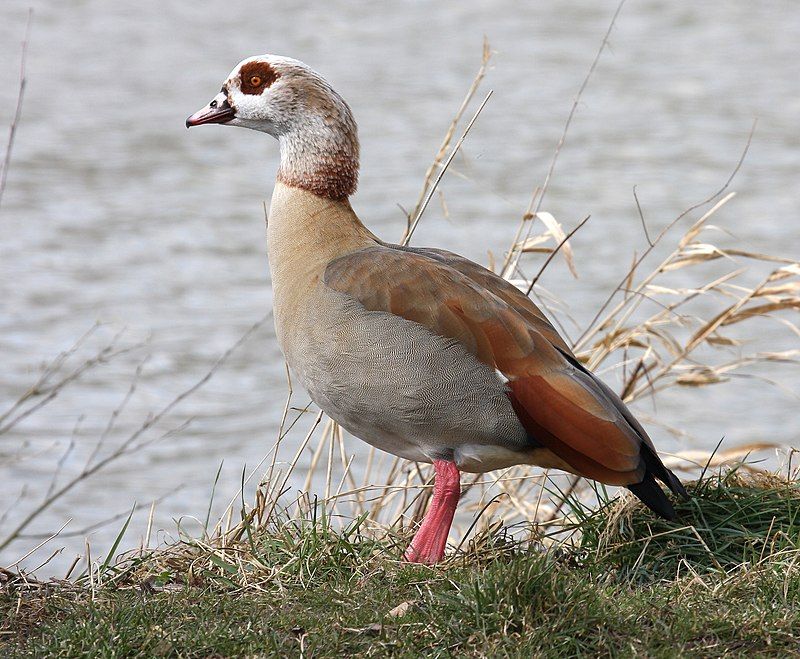
The Egyptian goose is a species of waterfowl that belongs to the Anatidae family, which includes ducks, geese, and swans.
Native to Africa, this goose species is popular for its ornamental value. It has been introduced to many areas outside its natural range, such as Europe and the United States.
The introduction of this species to areas outside of its native habitat is mainly due to its attractive look and the fact that it can be easily raised in captivity.
In its natural environment, the Egyptian goose inhabits wetlands and grasslands, providing the perfect environment to feed on aquatic plants, grasses, and grains.
They are known to form large flocks and can often be seen near large bodies of water, such as lakes and rivers.
They are highly social birds and often form breeding pairs that will remain together for life. The Egyptian goose is a medium-sized bird with an average weight of around 2.2 to 2.7 kilograms and a body length of 50 to 60 centimeters.
Their dark brown bodies have white and black patterns along their heads and necks.
They have a distinctive bill, which is yellowish-orange in color. Overall, the Egyptian goose provides an exciting addition to the avian species, being both attractive and memorable in appearance.
Due to its popularity, this species will likely continue to be introduced to regions outside of its natural range.
| Kingdom | Animalia |
| Phylum | Chordata |
| Class | Aves |
| Order | Anseriformes |
| Family | Anatidae |
| Genus | Alopochen |
| Species | A. aegyptiaca |
2. Yellow-billed Duck
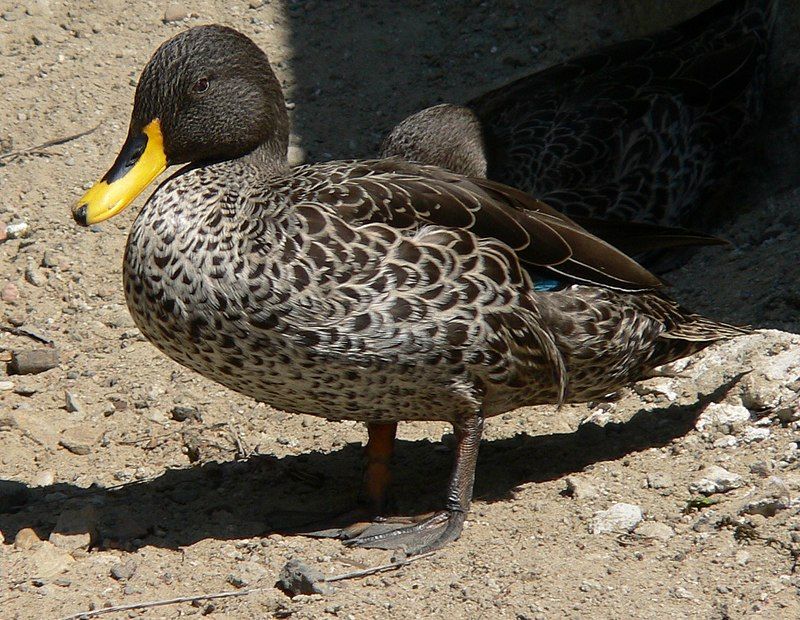
The yellow-billed Duck is a species of dabbling Duck native to southern and eastern Africa. It is a medium-sized bird, measuring between 51 and 58 cm long.
Unlike some other duck species, the yellow-billed Duck is not migratory but instead will sometimes move around in the dry season to find suitable waters. During this time of year, it is highly gregarious and can be seen in large flocks.
Breeding occurs in its native range, and the yellow-billed Duck is an abundant resident breeder. During the breeding season, the birds are more solitary, with individuals only coming together to breed.
The yellow-billed Duck is a highly adaptable species found in many habitats, including wetlands, lakes, rivers, and other bodies of water.
| Kingdom | Animalia |
| Phylum | Chordata |
| Class | Aves |
| Order | Anseriformes |
| Family | Anatidae |
| Genus | Anas |
| Species | A. undulata |
3. White-backed Duck
The white-backed Duck is a species of waterbird that belongs to the family Anatidae. It is unique from other ducks but shares many similarities with the whistling ducks in the subfamily Dendrocygninae.
It also has some features in common with the stiff-tailed ducks in the subfamily Oxyurinae. The white-backed Duck is the only species in the genus Thalassornis.
This means that it is not closely related to any other species within its family and is the only one of its kind. Its unique features have enabled it to survive in its environment, and it is a distinguished species among other waterbirds.
| Kingdom | Animalia |
| Phylum | Chordata |
| Class | Aves |
| Order | Anseriformes |
| Family | Anatidae |
| Genus | Thalassornis |
| Species | T. leuconotus |
4. Blue-billed Teal
The blue-billed teal, also known as the spotted teal or Hottentot teal, is a species of dabbling Duck native to eastern and southern Africa.
Its range stretches from Sudan and Ethiopia in the north to Niger and Nigeria in the west and South Africa and Namibia in the south.
In western Africa and Madagascar, the blue-billed teal is a permanent resident and does not migrate. The blue-billed teal is a small bird, only about 30 cm in length, with a wingspan of about 47 cm.
It has a distinctive blue bill, and males and females are similar in appearance, although males are slightly larger.
The upper parts of the bird are greyish-brown, while the underparts are white with brown streaks. The blue-billed teal is usually found in shallow freshwater wetlands, where it feeds on invertebrates, seeds, and plant material.
It is highly gregarious and will form large flocks when not breeding. Breeding usually occurs in the dry season, when the birds form pairs and build nests on the ground. The female lays up to 8 eggs, which are incubated for around three weeks.
The chicks can fly within six weeks of hatching. The blue-billed teal is considered to be of least concern by the IUCN due to its large population and wide distribution.
However, it is threatened by habitat loss and water pollution, and populations are declining in some areas. In addition, the blue-billed teal is hunted for food and sport in some countries.
| Kingdom | Animalia |
| Phylum | Chordata |
| Class | Aves |
| Order | Anseriformes |
| Family | Anatidae |
| Genus | Spatula |
| Species | S. hottentota |
5. Red-eyed Dove
The red-eyed dove is a species of dove found in Sub-Saharan Africa. It is widespread throughout its range and is considered to be of least concern regarding conservation status.
According to the International Union for Conservation of Nature (IUCN) Red List, the red-eyed dove has been listed as least concern since 2004. This means the species is not facing any immediate threat of extinction in the wild and is likely to remain abundant.
The red-eyed dove is a medium-sized bird, typically measuring around 33 cm long. Its bright red eyes, pale beige-brown upperparts, dark brown wings, and white belly characterize it.
The species is most commonly found in open grasslands, savannas, and agricultural areas, where it feeds on various seeds, fruits, and small invertebrates. It is considered a friendly bird, often foraging and breeding in flocks.
The red-eyed dove has a wide range throughout Sub-Saharan Africa, from Sudan and Ethiopia in the east to Senegal and Gambia in the west and southwards to South Africa.
The species is believed to be increasing in abundance and is estimated to have a total population of over 1 million individuals. It has adapted well to human disturbance and can survive in various habitats, including urban areas.
The red-eyed dove is a widespread species in Sub-Saharan Africa. It is listed as least concern on the IUCN Red List and will likely remain abundant.
| Kingdom | Animalia |
| Phylum | Chordata |
| Class | Aves |
| Order | Columbiformes |
| Family | Columbidae |
| Genus | Streptopelia |
| Species | S. semitorquata |
6. Gray Crowned Crane
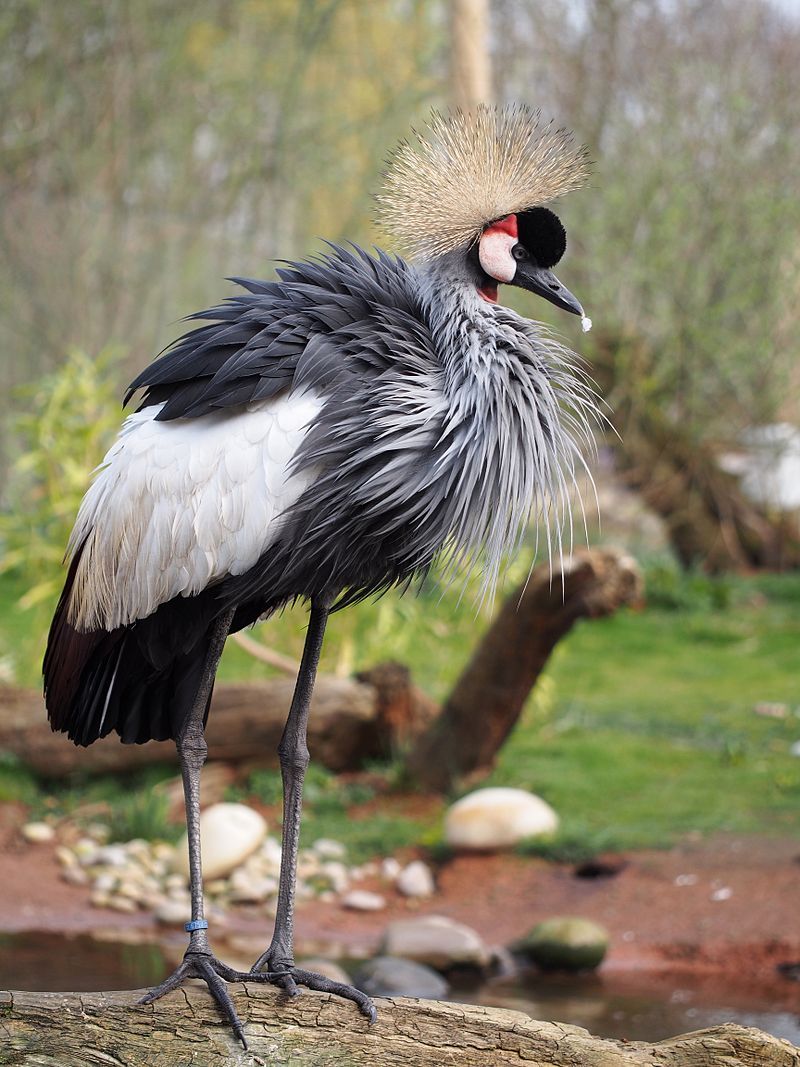
The grey-crowned crane is a beautiful bird considered an iconic African species. It is the national bird of Uganda and is found in the wetlands and grasslands of Sub-Saharan Africa.
It is an essential species in the crane family, Gruidae and is also known by a variety of different names, including the African crowned crane, golden crested crane, golden-crowned crane, East African crane, East African crowned crane, African crane, Eastern crowned crane, Kavirondo crane, South African crane, and crested crane.
This iconic bird has a distinct appearance: a grey body, white crest, and red and yellow feathers around the face and neck. The grey-crowned crane can reach up to three feet, making it one of the largest species.
They feed mainly on insects, small reptiles, amphibians, small mammals, and seeds, grains, and berries. The grey-crowned crane is an important species for many reasons.
They are highly sociable birds with a complex social structure and can often be found in large flocks. Additionally, they are important indicators of the health of wetlands and grasslands, as they are sensitive to environmental changes.
They also provide essential ecosystem services, such as pollinating plants and dispersing seeds, which help maintain healthy and productive habitats. Overall, the grey-crowned crane is a beautiful and crucial species of crane.
Its many different names reflect its widespread presence and importance in Africa. It is an essential species in the Gruidae crane family, providing many critical ecological services.
| Kingdom | Animalia |
| Phylum | Chordata |
| Class | Aves |
| Order | Gruiformes |
| Family | Gruidae |
| Genus | Balearica |
| Species | B. regulorum |
7. Chestnut-bellied Sandgrouse
The chestnut-bellied sandgrouse is a species of sandgrouse, a bird found across northern and central Africa and western and southern Asia.
It is a sedentary species, meaning it does not migrate but can be nomadic, traveling great distances in search of food and water. There are currently six recognized subspecies of this sandgrouse, each with different characteristics that set them apart.
For example, the Cape sandgrouse has a distinctive black and white plumage, whereas the Arabian sandgrouse has a more muted gray, brown, and white plumage. Other subspecies, such as the Somali and Indian sandgrouse, have different ranges and habitats.
All of the chestnut-bellied sandgrouse subspecies are distinct from one another, even though they all belong to the same species.
| Kingdom | Animalia |
| Phylum | Chordata |
| Class | Aves |
| Order | Pterocliformes |
| Family | Pteroclidae |
| Genus | Pterocles |
| Species | P. exustus |
8. Common Ostrich
The common ostrich is a species of large bird native to some regions of Africa. It is flightless, meaning it cannot fly, and is the only living member of the genus Struthio in the ratite order of birds.
This species is unique because it is the world’s most enormous giant bird, reaching heights of up to nine feet and weighing up to 346 pounds. It is also the fastest bird on two feet, reaching up to 43 miles per hour.
The common ostrich is also notable for its long neck and powerful legs, which help it to survive in its native habitat. These features, combined with its ability to eat various plants, fruits, and insects, make it well-adapted to life in the wild.
The common ostrich is an integral part of African culture and often symbolizes strength, courage, and resilience.
| Kingdom | Animalia |
| Phylum | Chordata |
| Class | Aves |
| Order | Struthioniformes |
| Family | Struthionidae |
| Genus | Struthio |
| Species | S. camelus |
9. Fulvous Whistling Duck
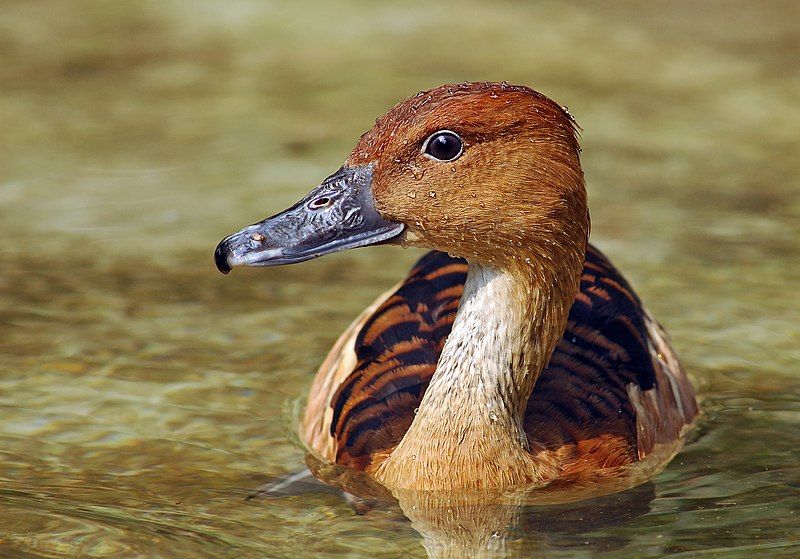
The Fulvous Whistling Duck is a species of whistling Duck found in many parts of the world. It is found in tropical regions such as Mexico, South America, the West Indies, the southern United States, sub-Saharan Africa, and the Indian subcontinent.
This species of Duck prefers to inhabit wetlands and swamps, where it can feed on aquatic plants and other small creatures. It is easily recognizable by its yellow-brown feathers, long neck, and long, curved bill.
The Fulvous Whistling Duck is a vocal species whose distinctive whistle can be heard across the wetlands. It is a social species and often lives in small groups or flocks.
This species has a long history of being hunted for its meat, eggs, and feathers, which has led to a decline in its population in some areas. Conservation efforts have been put in place in many areas to help protect this species and its habitat.
| Kingdom | Animalia |
| Phylum | Chordata |
| Class | Aves |
| Order | Anseriformes |
| Family | Anatidae |
| Genus | Dendrocygna |
| Species | D. bicolor |
10. Spur-winged Goose
The spur-winged goose is a large waterbird native to the Sub-Saharan African region. It is part of the Anatidae family, comprised of geese and shelducks. These birds are considered significant, with a wingspan between 70 and 90 centimeters.
Furthermore, these birds are typically found in wetland areas such as swamps, marshes, and shallow lakes, where they feed on aquatic vegetation. The spur-winged goose is a distinctive-looking bird with a white body and black wingtips.
These birds are also known for their loud honking calls and their curious behavior, often seen swimming in flocks or wading in shallow water. They are also notable for their monogamous pairings, often forming lifelong relationships with a single mate.
The spur-winged goose is a fascinating bird with unique features and behaviors.
| Kingdom | Animalia |
| Phylum | Chordata |
| Class | Aves |
| Order | Anseriformes |
| Family | Anatidae |
| Genus | Plectropterus |
| Species | P. gambensis |
11. Knob-billed Duck
The knob-billed Duck, also known as the African comb duck, is a species found in many parts of the world. It is primarily found in the wetlands and waterways of Sub-Saharan Africa, Madagascar, and much of South Asia and mainland Indochina.
Its scientific name is Sarkidiornis melanotos.This species of Duck gets its name from the knob, or bump, located on its bill. This bump is used to help it search for food along the bottom of the wetlands and waterways it inhabits.
It is also known for its broad, flat tail feathers, which are used to help it swim. Despite their similarities, most taxonomic authorities classify the nob-billed Duck and the comb duck separately by most taxonomic authorities.
Besides the knob-billed Duck’s bill, the main difference between the two is the comb duck’s white-tipped feathers. The knob-billed Duck’s feathers are more rounded and lack white tips.
| Kingdom | Animalia |
| Phylum | Chordata |
| Class | Aves |
| Order | Anseriformes |
| Family | Anatidae |
| Genus | Sarkidiornis |
| Species | S. melanotos |
12. Red-billed Duck
The red-billed teal, also known as the red-billed Duck, is a dabbling Duck found in abundance in southern and eastern Africa. It is a non-migratory species that will fly long distances to find suitable waters.
This Duck is highly social and prefers to form large flocks, particularly during the non-breeding season. This species is adapted to living in various habitats, including wetlands, rivers, and lakes.
It has been observed that this species is typically found south of 10° S, though it has been observed in other areas as well.
Its diet consists mainly of plant material, such as seeds and invertebrates, which it obtains while dabbling in shallow waters. The red-billed teal is also a highly territorial species, and pairs often defend their territory during the breeding season.
The females will lay up to 11 eggs, which, after hatching, will be tended to by both the male and female. After a few weeks, the ducklings will be able to fly and will join the larger flocks. The red-billed teal is a valuable species, both ecologically and economically.
It provides an essential food source for humans and other predators and helps maintain healthy aquatic ecosystems. It is also necessary for recreational activities such as birdwatching and hunting.
| Kingdom | Animalia |
| Phylum | Chordata |
| Class | Aves |
| Order | Anseriformes |
| Family | Anatidae |
| Genus | Anas |
| Species | A. erythrorhyncha |
13. Black-winged Stilt
The black-winged stilt is a wading bird species found in many areas worldwide. It is part of the avocado and stilt family known for having long legs. Its scientific name is H.
Himantopus, indicating that it is a single, almost universally distributed species. The black-winged stilt is found on most continents but is absent from Antarctica. It is typically found in wetlands, such as marshes, lakes, and ponds.
It is a medium-sized wading bird, measuring 7-14 inches long, and has a wingspan of up to 21 inches.
It has a white plumage with black flight feathers and a black tail, and its legs are typically bright red. The black-winged stilt feeds on aquatic invertebrates, including beetles, crustaceans, and small fish.
It has a fondness for brine shrimp, which picks off the water’s surface. It also eats frogs, insects, and other small animals—the black-winged stilt breeds in areas with shallow, fresh water and plenty of vegetation.
It builds its nest on the ground, using sticks, grass, and other materials. The female lays 2-3 eggs, which are incubated for around 21 days. When the chicks hatch, they are fed by both parents.
The black-winged stilt is listed as a species of most minor concern by the IUCN, as its population is thought to be stable. It faces some threats from habitat destruction and hunting, but its wide distribution means it is not at risk of extinction.
| Kingdom | Animalia |
| Phylum | Chordata |
| Class | Aves |
| Order | Charadriiformes |
| Family | Recurvirostridae |
| Genus | Himantopus |
| Species | H. himantopus |
14. Greater Flamingo
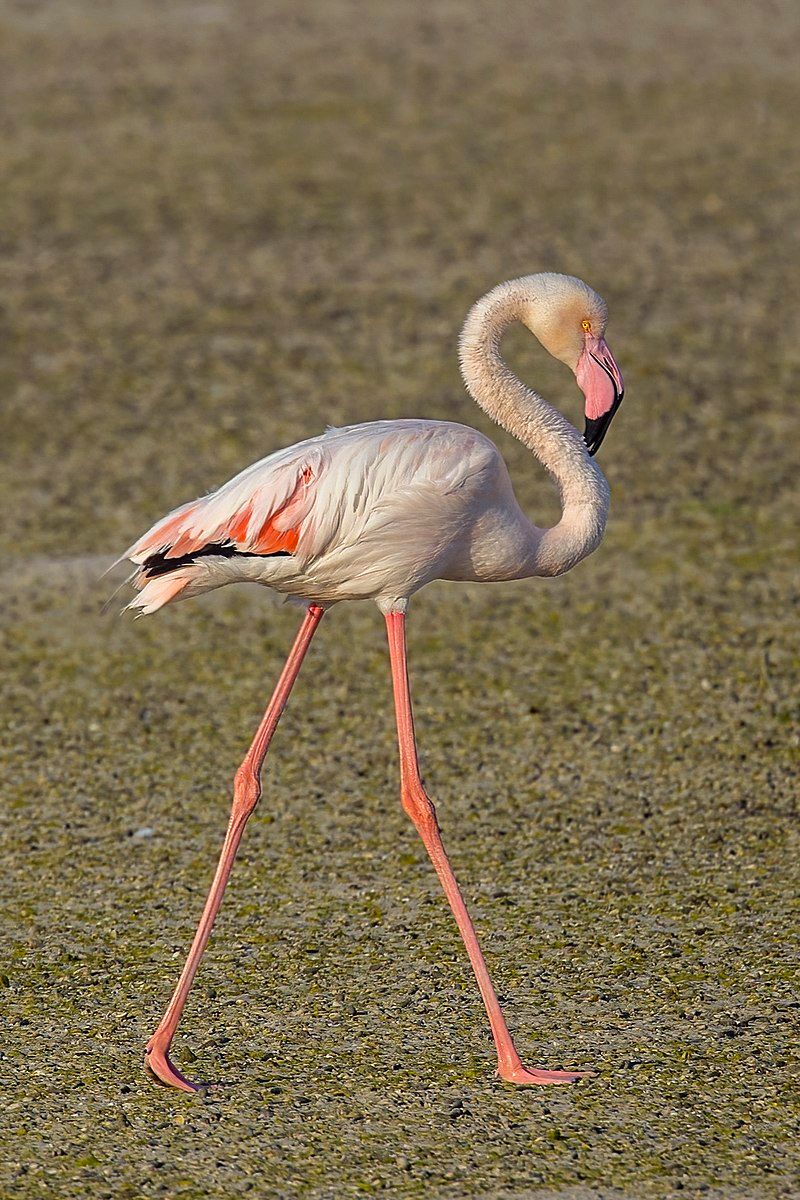
The greater flamingo is an iconic bird species widely distributed throughout the Old World. It is the largest species within its flamingo family and can be found in many regions across the continent.
In Africa, they are found in the Northern and Sub-Saharan regions. In contrast, in the Indian Subcontinent, Middle East, Levant, Persian Gulf, Gulf of Aden, Red Sea, and Mediterranean countries of Southern Europe, they are also found in abundance.
The flamingo is known for its incredibly long legs, bright pink feathers, and signature curved bill. These unique characteristics make it a widespread species that bird watchers widely recognize worldwide.
Its habitats range from shallow lakes and coastal lagoons to large rivers and wetlands. The flamingo feeds on small crustaceans, insects, and algae, which it filters from the water with its specially adapted bill.
The greater flamingo is an important species to the global ecosystem, as it helps to maintain the balance of the local environment by controlling the population of its prey.
| Kingdom | Animalia |
| Phylum | Chordata |
| Class | Aves |
| Order | Phoenicopteriformes |
| Family | Phoenicopteridae |
| Genus | Phoenicopterus |
| Species | P. roseus |
15. Ferruginous Duck
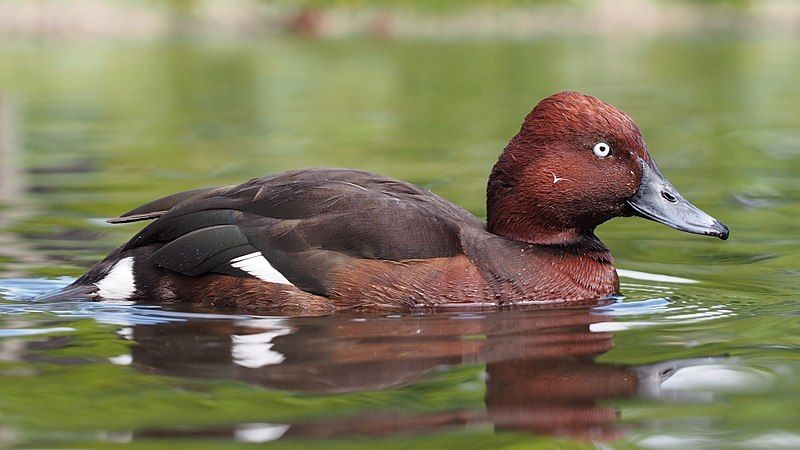
The ferruginous Duck is a species of diving Duck native to Eurosiberia. Various other names, such as ferruginous, common white-eye, and white-eyed pochard, also know it.
These different names refer to its distinct appearance, which features a rusty brown color on its wings and back, with a white patch around its eyes.
The scientific name for the Duck is derived from Greek, precisely the word “with Lithuania,” which early writers such as Hesychius and Aristotle used to refer to an unknown seabird. Additionally, the name includes the Russian word “nyrok,” which translates to “duck.”
The ferruginous Duck is a medium-sized diving duck with an average body length of 45-50 cm. Its diet includes aquatic plants and animals, such as plant roots, fish, insects, and mollusks.
Its primary habitat consists of shallow wetlands, such as marshes and lakes, with some populations also inhabiting larger rivers. The ferruginous Duck is an essential species in Eurosiberia and is currently listed as Vulnerable by the IUCN Red List.
Its population is threatened by pollution, hunting, and habitat loss, making it an important species to protect.
| Kingdom | Animalia |
| Phylum | Chordata |
| Class | Aves |
| Order | Anseriformes |
| Family | Anatidae |
| Genus | Aythya |
| Species | A. nyroca |
16. Blue Quail
The blue quail is a bird native to sub-Saharan Africa, belonging to the Phasianidae family. It is also known as the African blue quail and is considered a medium-sized bird.
Its body is mainly a deep shade of blue, with a lighter belly and a white stripe running along its wings. Its head is a darker blue, and its eyes are black.
The blue quail typically inhabits open grassy areas and can be found near water sources such as lakes, rivers, and streams. It feeds on tiny seeds, insects, and other small creatures.
The blue quail is a shy and skittish species, and they usually move in flocks of up to thirty individuals. It is a ground-dwelling bird and nests in shallow depressions in the ground.
The blue quail is not considered a threatened species, although its population is declining due to habitat destruction and hunting.
| Kingdom | Animalia |
| Phylum | Chordata |
| Class | Aves |
| Order | Galliformes |
| Family | Phasianidae |
| Genus | Synoicus |
| Species | S. adansonii |
17. Great Crested Grebe
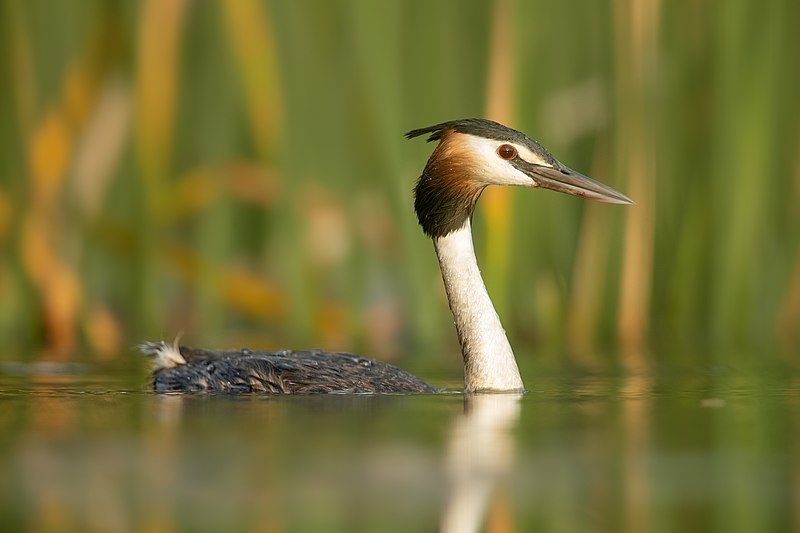
The great crested grebe is a species of bird native to wetlands in Europe and parts of Asia. It is a member of the Grebe family, a group of water birds characterized by their long, slender necks, short legs, and lobed feet.
The great crested grebe is particularly renowned for its unique courtship display. During mating season, males perform elaborate dance-like movements with their heads and necks and even build floating nests to attract mates.
The female will then join in the dance, and when the couple is satisfied, they will mate, and the female will lay her eggs in the floating nest. The great crested grebe is an impressive species of water bird well known for its elaborate mating display.
| Kingdom | Animalia |
| Phylum | Chordata |
| Class | Aves |
| Order | Podicipediformes |
| Family | Podicipedidae |
| Genus | Podiceps |
| Species | P. cristatus |
18. Hartlaub’s Bustard
Hartlaub’s bustard is a species of bird found in the family Otididae. It is native to the African countries of Ethiopia, Kenya, Somalia, Sudan, Tanzania, and Uganda. The bird prefers to inhabit open grasslands with grass reaching up to 1800 meters in height.
It is named after the German physician and ornithologist Gustav Hartlaub, who first discovered the species. Hartlaub was a renowned ornithologist who studied birds in his native country and Africa. The first species he discovered was Hartlaub’s bustard.
His discovery led to the species being named after him, with the Latin binomial honoring his name. He was also the first to describe the species’ anatomy and behavior in detail. Hartlaub’s bustard is a medium-sized bird, measuring around 70 centimeters.
It has a long neck, a short tail, a rounded head, and a black and white patterned pattern on its back and sides. Its diet consists mainly of seeds, insects, and small invertebrates.
It is also known to feed on carrion occasionally. The species is considered to be of least concern by the IUCN, as its population is supposed to be stable. It is relatively common throughout its range and has adapted to some human disturbance.
Conservation efforts, such as habitat protection, are in place to ensure the species’ continued survival. Hartlaub’s bustard is an interesting species of bird found in the African countries of Ethiopia, Kenya, Somalia, Sudan, Tanzania, and Uganda.
It is named after the German ornithologist Gustav Hartlaub, who discovered the species. The bird is of minor concern to the IUCN, and conservation efforts are in place to protect its habitat and ensure its continued survival.
| Kingdom | Animalia |
| Phylum | Chordata |
| Class | Aves |
| Order | Otidiformes |
| Family | Otididae |
| Genus | Lissotis |
| Species | L. hartlaubii |
19. Common Sandpiper
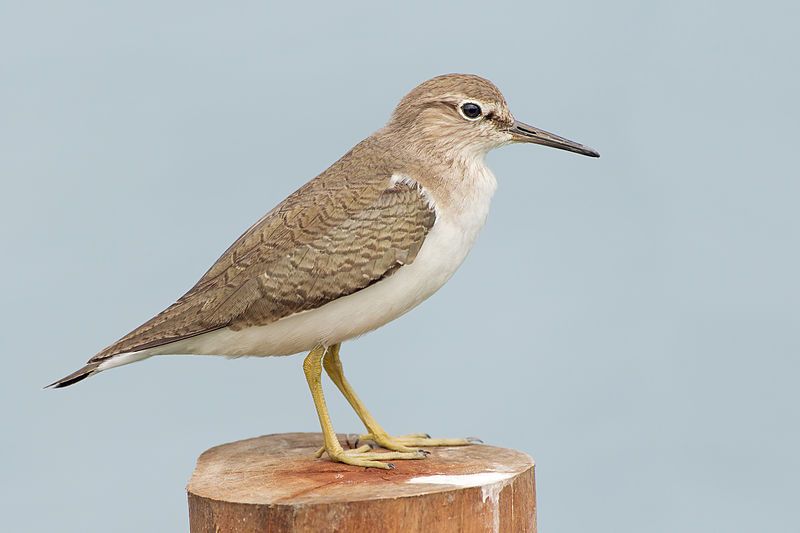
The common sandpiper is a species of wader found in the Palearctic region, located in the Northern Hemisphere, and encompasses Europe, parts of North Africa, and parts of Asia.
The common sandpiper is closely related to the American spotted sandpiper; together, they make up the genus Actitis.
These two species of sandpipers are described as parapatric, meaning they generally occupy separate geographical areas, although there is some overlap.
On occasions, birds of either species may settle down with breeders of the other and hybridize, creating a hybrid offspring. Hybridization is quite rare, however, as the two species have evolved to have distinct habits and behaviors.
| Kingdom | Animalia |
| Phylum | Chordata |
| Class | Aves |
| Order | Charadriiformes |
| Family | Scolopacidae |
| Genus | Actitis |
| Species | A. hypoleucos |
20. African Harrier-hawk
The African harrier-hawk, also known as the harrier hawk or zymogen, is an impressive bird of prey. It is a large species of raptor with a total length of 60 to 66 cm.
It is found in most of Africa south of the Sahara desert, making it one of the most widespread species of its kind on the continent. It has only one other relative, the Madagascar harrier-hawk, found in Madagascar and is not closely related.
The African harrier-hawk is a large, stocky raptor with broad wings and a long tail. It has a dark brown and white mottled coloration, with pale underparts. Its head is white, with a black stripe running from its beak to the back of its head.
Its legs are yellow, and its eyes are yellow-orange. They are quite agile and have remarkable flight capabilities. African harrier hawks feed on small animals, such as rodents, reptiles, and insects.
They are also known to hunt other birds, such as pigeons, and will sometimes scavenge carrion.
They are often seen soaring in the sky, using their sharp eyesight and impressive aerial agility to hunt their prey. The African harrier-hawk is a solitary bird and is usually only seen alone. They typically nest in trees and can be seen perched on low branches.
They are not often seen in large groups, but sometimes small flocks of up to 10 birds roost in the same tree. The African harrier-hawk is a fascinating raptor species and an essential part of the African ecosystem.
It is an impressive bird of prey, and its remarkable flight capabilities make it a sight to behold.
| Kingdom | Animalia |
| Phylum | Chordata |
| Class | Aves |
| Order | Accipitriformes |
| Family | Accipitridae |
| Genus | Polyboroides |
| Species | P. typus |
21. Abyssinian Thrush
The Abyssinian thrush is a species of bird from the family Turdidae, also referred to as the African mountain thrush or northern olive thrush. This species has been identified as distinct from the olive thrush in 2010 due to differences in their genetic makeup.
This means that the two species’ ranges do not overlap, with the Abyssinian thrush occupying a range separate from the olive thrush. The Abyssinian thrush is found mainly in the African region, including Ethiopia, Eritrea, and Somalia, among other countries.
It is a ground-dwelling bird that inhabits mountain forests and scrubland and occasionally visits gardens and agricultural land. It feeds mainly on insects, as well as some fruits and berries.
The Abyssinian thrush is an essential species in its ecosystem, providing critical pest control services and helping to maintain the balance of the food web.
| Kingdom | Animalia |
| Phylum | Chordata |
| Class | Aves |
| Order | Passeriformes |
| Family | Turdidae |
| Genus | Turdus |
| Species | T. abyssinicus |
Conclusion
Birds are essential in Kiambu, providing food, pollination, pest control, and other vital environmental services. They are a critical part of the ecosystem, and their presence should be celebrated and protected.
With the proper management and conservation efforts, the birds of Kiambu can continue to thrive and support the local environment for many generations.